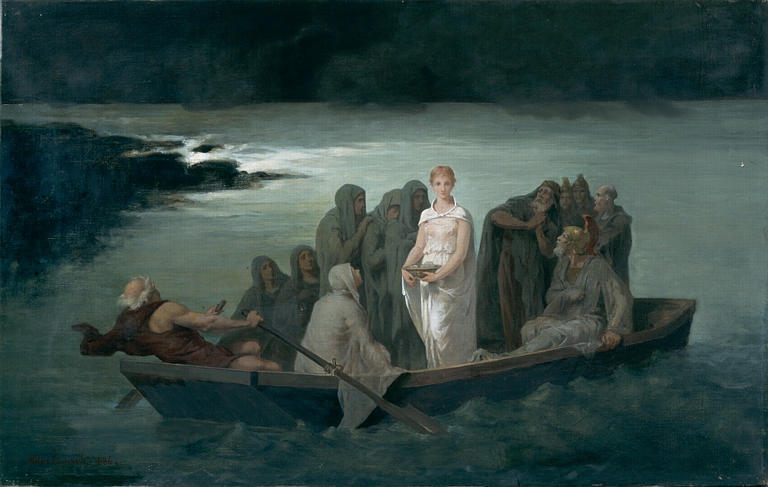Reading visual art: 139 Ferry

Before the nineteenth century, many river and sea crossings had to be made by ferry, and that’s reflected in paintings. The best-known in mythology is the crossing made by the dead into the Underworld, a service operated by Charon. What is more disputed is which body of water his boat crosses: to the Greeks, it was normally the swamps of the River Acheron, which is maintained in Dante’s account in his Inferno, but later Roman writers follow Virgil’s Aeneid and name it the River Styx.
Eugène Delacroix (1798–1863), The Barque of Dante (Dante and Virgil in Hell) (1822), oil on canvas, 189 x 241 cm, Musée du Louvre, Paris. Wikimedia Commons.
In 1822, the young Eugène Delacroix painted one of his finest narrative works, The Barque of Dante, showing Dante and Virgil crossing a stormy river Acheron in a very small boat on their way into the Underworld, at the start of the Inferno.
Alexander Dmitrievich Litovchenko (1835-1890), Charon Carrying Souls Across the River Styx (1861), oil on canvas, dimensions not known, Russian Museum, Saint Petersburg, Russia. Wikimedia Commons.
For Alexander Dmitrievich Litovchenko, in his Charon Carrying Souls Across the River Styx from 1861, it was the Styx.
José Benlliure y Gil (1855–1937), Charon’s Boat (date not known), oil on canvas, 103 x 176 cm, Museu de Belles Arts de València, Valencia, Spain. Wikimedia Commons.
José Benlliure’s undated Charon’s Boat wisely remains uncommitted.
Myths also bring some famous ancient crossings, including that of Psyché.
Évariste Vital Luminais (1821–1896), Psyché (1886), oil on canvas, 52 x 82 cm, Musée des Beaux-Arts de Nantes, Nantes, France. Wikimedia Commons.
In 1886, Évariste Vital Luminais took a break from his paintings of early French history with Psyché, drawing from the novel written by Apuleius in the second century CE, which had been rediscovered in the Renaissance. She set off on a quest to find her husband Cupid, taking her through a succession of trials imposed by Venus. The last of these was to take a box (in Greek, pyxis) to obtain a dose of the beauty of Proserpine, Queen of the Underworld. Psyche made her way to its entrance, and paid Charon the ferryman two coins for her near-unique return trip.
Luminais chooses to show what is probably the key moment in the whole novel, and a peripeteia of sorts: Psyche, picked out in white and clutching the pyxis in both hands, is being rowed across to the underworld by Charon, with a boatful of the dead. She stares straight at the viewer, an unusually powerful pictorial choice.
The other notable return trip was that of Orpheus, in his quest to release Eurydice from the Underworld.
John Roddam Spencer Stanhope (1829–1908), Orpheus and Eurydice on the Banks of the Styx (1878), oil on canvas, dimensions and location not known. Wikimedia Commons.
John Roddam Spencer Stanhope’s Orpheus and Eurydice on the Banks of the Styx (1878) takes the couple onto the bank, where Orpheus is summoning Charon the boatman to take them back across the water. He clutches her closely and still looks straight ahead, the couple bound together by the black sash of the Underworld.
The centaur Nessus ferried people across the River Euenos, and came to a premature end when he tried to abduct Heracles’ bride Deianira. This is a notoriously difficult compositional problem in visual art.
Antonio del Pollaiolo (1431–1498), Hercules and Deianira (c 1475–80), oil on panel transferred to canvas, 54.6 × 79.2 cm, Yale University Art Gallery, New Haven, CT. Wikimedia Commons.
Antonio del Pollaiolo’s painting from about 1475–80 tries a side-on view, requiring Nessus to be shot while he’s still in the river, in a slight adjustment of the original story. Deianeira appears precariously balanced, and must be grateful that Nessus’ muscular arms save her from being dropped into the river below. The artist also leaves it to the viewer to know that Heracles’ poisoned arrow strikes Nessus rather than Deianeira.
Guido Reni (1575–1642), The Abduction of Deianeira (1617-21), oil on canvas, 239 x 193 cm, Musée du Louvre, Paris. Wikimedia Commons.
Guido Reni’s masterly painting from around 1620, one of the finest of its period in the Louvre, almost fills the canvas with Nessus, who looks worryingly heroic, and Deianeira, who seems to be flying. The small figure of Heracles in the distance is well lit, but loses the details of bow and arrow.
Ferries also feature in non-narrative paintings.
Aelbert Cuyp (1620–1691), The Passage Boat (c 1650), oil on canvas, 124 x 144.4 cm, Royal Collection of the United Kingdom, UK. Wikimedia Commons.
Although Aelbert Cuyp never seems to have become a more dedicated marine specialist, his paintings of ships including The Passage Boat from about 1650, are landmarks at the height of his career. These ships engaged in regular ferry trips between set ports, in this case probably Dordrecht and Rotterdam, a distance of little more than twelve miles (20 km) by river. With its extensive networks of rivers and canals, these were a popular means of transport at the time. The figures in the boat are finely detailed, and include a drummer towards the stern.
Adriaen van de Velde (1636–1672), The Ferry (1666), oil on canvas, 34 x 37.5 cm, Rijksmuseum Amsterdam, Amsterdam. Wikimedia Commons.
In the late 1660s, Adriaen van de Velde painted increasingly complex figures and compositions, such as the more modest vessel in The Ferry from 1666.
JMW Turner was familiar with the packet boats transporting people and goods between English and French ports on the Channel coast.
Joseph Mallord William Turner (1775–1851), Calais Pier, with French Poissards preparing for Sea: an English Packet arriving (1803), oil on canvas, 172 x 240 cm, The National Gallery (Turner Bequest, 1856), London. Image courtesy of and © The National Gallery.
In 1802, during the lull between the French Revolution and the Napoleonic Wars, Turner turned his attentions to the European continent. He crossed from Dover to Calais, the shortest route but often a rough one, and caught the sea when it was less comfortable. He painted the scene of his arrival in France in Calais Pier, with French Poissards preparing for Sea: an English Packet arriving (1803), where the French fishermen still seem happy to head out in search of a catch.
Rosa Bonheur (1822–1899), Changing Pastures (1863), oil on canvas, 64 x 100 cm, Hamburger Kunsthalle, Hamburg, Germany. Wikimedia Commons.
One of Rosa Bonheur’s finest paintings from Scotland is Changing Pastures, painted in 1863. This flock of sheep is being rowed to fresh grazing on an island in one of the many lochs.
Into the twentieth century, there were many parts of Europe that still relied on small ferry boats for local transport.
Edward Stott (1855–1918), The Ferry (1887), oil on canvas, 68 x 119 cm, Oldham Gallery, Oldham, England. Wikimedia Commons.
Edward Stott’s The Ferry, from 1887, proved an early success, and was exhibited at the New English Art Club that year. This bucolic scene is set in Winchelsea in East Sussex. By this time, Stott had moved to Amberley, at the foot of the South Downs near Arundel in West Sussex, where he lived until his death in 1918.
Serhii Svitoslavskyi (1857–1931), A Ferry over the River Dnipro (c 1905), media and dimensions not known, National Art Museum of Ukraine Національний художній музей України, Kyiv, Ukraine. Wikimedia Commons.
Finally, a painting by Ukrainian landscape artist Serhii Svitoslavskyi of his favourite river, showing this Ferry over the River Dnipro from the early years of the twentieth century. Its prime purpose seems to be the transport of cattle across this major waterway.

